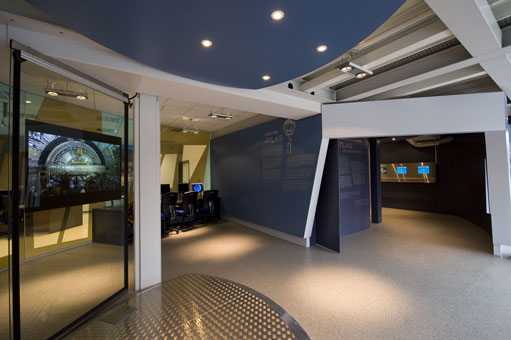
ATLAS e-News
23 February 2011
Visitors' centre opens its doors
9 March 2009

The view walking into the visitor's centre
Just eight months after the diggers thundered in to lay its foundations, the ATLAS Visitors Centre has opened its shiny new doors to the public. Officially launched on Monday February 23rd, the permanent exhibition at Point 1 was conceived as a tour resource for ATLAS guides, and as a way to preserve the public’s opportunity to get a close-up look at the experiment in action when the cavern is sealed.
The centrepiece of the exhibition is the ATLAS Control Room, screened behind thick floor-to-ceiling glass to ensure that shifters can get on with their tasks undisturbed. Where the previous highlight for visitors would almost certainly have been going underground to view the detector, the window on to the Control Room gives them a tangible real-time impression of what it is to be a physicist working on ATLAS right now. The window looks in from a back corner of the Control Room.

Window on the Control Room
In the middle of the exhibition space, an interactive screen is sandwiched between two large slabs of glass. It hosts a suite of short information films and a virtual 3-D tour. Here, visitors can pick from several vantage points in the cavern and control the viewing angle to take in all of the surrounding area. The incredibly hi-tech glass contraption responds to hovering hand gestures in front of the screen, and allows viewers to walk right around it by 360 degrees.
The technological aspect of the exhibition was one of the key planning criteria according to its designer, Juliette Davenne. She discovered the glass interactive screen while “hunting for gadgets” at a seminar in Finland, and then made it her mission to track down someone who could make one for ATLAS.

The hi-tech screen among other exhibits
Of equal importance to the hi-tech wizardry were the aesthetics of the layout and design. Juliette envisaged something where beauty and functionality would go hand in hand. Working with an architect, she stipulated that she would like different areas of the exhibition to answer different questions: the Who? Where? What? When? Why? and How? of ATLAS.
The modern ‘clean-lines’ feel of the space is aided by the fact that most of the exhibition’s extensive content is delivered via interactive screens. You can explore each of the sub-detectors, learn about the construction of ATLAS, see screen images from the control room in real-time, and watch Grid activity across the globe in real-time; there are games and quizzes covering topics such as the Higgs, antimatter, and the trigger system; and there are sample pieces of some of the sub-detectors available for close inspection.
In other areas, the people-power behind ATLAS is highlighted at both ends of the scale. On one side of the room, near the Control Room window, visitors can click on images of personnel and read quotes and tales about their backgrounds, their hobbies, their dreams, or their thoughts on the best and worst aspects of being a particle physicist. On the opposite side of the exhibition space, a spinning globe is projected onto a hemisphere, with real-time geographical hits on the website atlas.ch showing up as little lights.

The spinning globe
“It is really a showroom, a communication platform for ATLAS,” says Juliette, who consulted with ATLAS guides about what resources would be most useful for them during tours. “I decided to follow the ATLAS Communication Plan and focus on teenagers, to encourage them to follow scientific studies,” she adds. With the help of a team of ATLAS physicists and Outreach regular Helfried Burckhart in particular, she then designed the exhibition’s content, with the aim that the interactive elements would allow each visitor – novice or expert physicist – to “function at [their] own level of knowledge”.
"I never imagined that one could modify a square conference room in a square building into something so nice, that looks as if it had been planned in from the beginning," comments Helfried. He now envisages the Visitors Centre as the most important ‘module’ of an ATLAS visit, which can be combined with other ‘modules’ such as the 3-D film, seminars on specific topics, and potential underground tours.
At the official opening of the Visitors Centre, Helfried stressed that the exhibition is intended to be ever-evolving, and encouraged collaborators to contribute any ideas they might have. Meanwhile, Juliette is spending time in the Visitors Centre, watching how people move around the space and interact with the exhibits, then making small adjustments to improve them.

Ceri PerkinsATLAS e-News
|